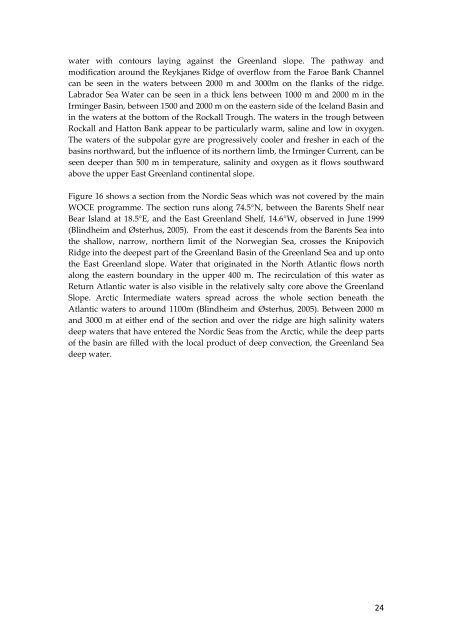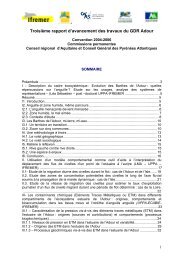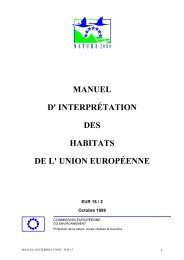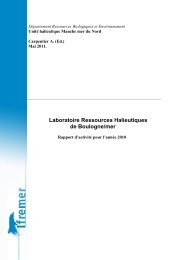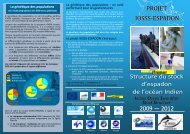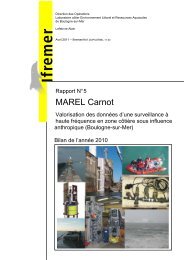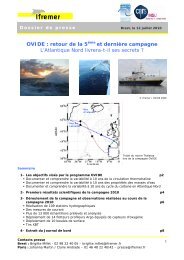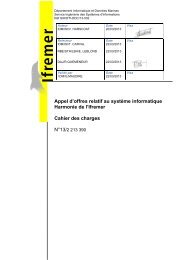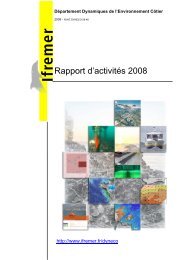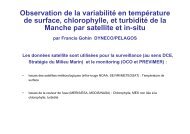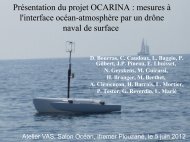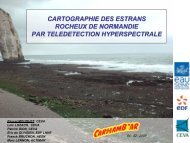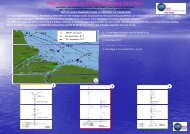- Page 1 and 2: DEEPFISHMANManagement And Monitorin
- Page 3 and 4: 1. Salient characteristics of the d
- Page 5 and 6: DEEPFISHMAN case study fleet that p
- Page 7 and 8: Figure 2. NE Atlantic - Deep (> 200
- Page 9 and 10: Fracture zone, between the Greenlan
- Page 11 and 12: Figure 4 Location of carbonate moun
- Page 13 and 14: and the frequency of observation wh
- Page 15 and 16: countries to make in-situ and satel
- Page 17 and 18: Figure 9. One of the mooring arrays
- Page 19 and 20: Figure 11. Barents Sea Standard Sec
- Page 21 and 22: temperature and salinity, which are
- Page 23: Figure 14. WOCE section A24S (the s
- Page 27 and 28: Figure 17. Modified from Stramma et
- Page 29 and 30: that of the atmosphere on time scal
- Page 31 and 32: Figure 21. Time-series from the Ice
- Page 33 and 34: Figure 22. Height in cm of the prin
- Page 35 and 36: Dickson et al (1996) found evidence
- Page 37 and 38: global ocean leads to niche and res
- Page 39 and 40: The combination of physical charact
- Page 41 and 42: most dominant source of primary pro
- Page 43 and 44: a framework for describing function
- Page 45 and 46: Table 1. Classification scheme modi
- Page 47 and 48: The primary production at hydrother
- Page 49 and 50: ocean colonisation. Calcium carbona
- Page 51 and 52: Figure 27. The distribution of cold
- Page 53 and 54: The biological diversity of coral g
- Page 55 and 56: The fauna associated with the spong
- Page 57 and 58: The most species-rich environments
- Page 59 and 60: 2.8.1. Ecosystem structureEcosystem
- Page 61 and 62: In general, an indicator can be def
- Page 63 and 64: Table 3. List of indicators from th
- Page 65 and 66: affects the longevity of a given sp
- Page 67 and 68: significant interactions between hu
- Page 69 and 70: Define Appropriate SpatialManagemen
- Page 71 and 72: flow of energy from primary produce
- Page 73 and 74: disease is usually superficial and
- Page 75 and 76:
Atlantic). In none of these cases w
- Page 77 and 78:
complete lifecycles of deep-water d
- Page 79 and 80:
of other hosts, including Nototheni
- Page 81 and 82:
parasite within the tissues. It is
- Page 83 and 84:
Order Family Genus Number deepwater
- Page 85 and 86:
classifiers are combined by majorit
- Page 87 and 88:
information on stock status and fis
- Page 89 and 90:
Development. This resolution also c
- Page 91 and 92:
of populations, communities and hab
- Page 93 and 94:
over the increase of shark catches
- Page 95 and 96:
On the basis of specified criteria
- Page 97 and 98:
• the plans should also aim at di
- Page 99 and 100:
the industry to identify technical
- Page 101 and 102:
A requirement to land all fish will
- Page 103 and 104:
interactions and applying an integr
- Page 105 and 106:
equested Scientific, Technical and
- Page 107 and 108:
(4) all elements of the marine food
- Page 109 and 110:
e.g. control and safety at sea. In
- Page 111 and 112:
several stocks from recovering in s
- Page 113 and 114:
• disturbance to sea bed communit
- Page 115 and 116:
smooth oreo, 150t for other oreos,
- Page 117 and 118:
emit of the CCAMLR. Here, we focus
- Page 119 and 120:
on the high seas with the discovery
- Page 121 and 122:
stocks deeper than 600 m. There is
- Page 123 and 124:
target, the MEY (Maximum Economic Y
- Page 125 and 126:
Rebuilding strategies are developed
- Page 127 and 128:
stock biomass is below that limit i
- Page 129 and 130:
fishers to pay the charge requested
- Page 131 and 132:
ecent surveys have combined acousti
- Page 133 and 134:
Table 8. Main features of the manag
- Page 135 and 136:
Figure 40. Continental margin off B
- Page 137 and 138:
southeastern and southern coasts (2
- Page 139 and 140:
Table 9. Spatial distribution of de
- Page 141 and 142:
5.2.5. Fisheries-independent survey
- Page 143 and 144:
Annual catches increased from 13 t
- Page 145 and 146:
gillnets on large K-strategists (wr
- Page 147 and 148:
Table 12. Management elements of th
- Page 149 and 150:
Figure 41. Map of CCAMLR convention
- Page 151 and 152:
The essential problem with using su
- Page 153 and 154:
(c) prevention of changes or minimi
- Page 155 and 156:
(certified 2004, recertified with n
- Page 157 and 158:
VMS data are only available from 20
- Page 159 and 160:
target aggregations associated with
- Page 161 and 162:
All fishing activities for fisherie
- Page 163 and 164:
advises the Commission as to whethe
- Page 165 and 166:
Deep-water coral reefs are local se
- Page 167 and 168:
400 and 800 m (Cartes and Sardà, 1
- Page 169 and 170:
Red shrimp resources have shown som
- Page 171 and 172:
The official landings of the Italia
- Page 173 and 174:
The trawl fishery in the Greek Ioni
- Page 175 and 176:
In Turkish waters, although GFCM (2
- Page 177 and 178:
Italycomputerized yet and depends o
- Page 179 and 180:
Pagellus bogaraveo:Moderately explo
- Page 181 and 182:
opinion from some scientists from t
- Page 183 and 184:
5.6. North Atlantic (NAFO, NEAFC an
- Page 185 and 186:
speed above 8 knots to ensure that
- Page 187 and 188:
e introduced in Regulation 1359/200
- Page 189 and 190:
From a monitoring standpoint, the N
- Page 191 and 192:
(C/B) indices indicate show a decre
- Page 193 and 194:
set up for spatial protection measu
- Page 195 and 196:
measures designed to achieve of mai
- Page 197 and 198:
compiles an annual report on single
- Page 199 and 200:
6. Views of stakeholders in NE Atla
- Page 201 and 202:
Table 18. SWOT (Strengths, Weakness
- Page 203 and 204:
(a)(b)Nothing should changen = 42Ot
- Page 205 and 206:
The technical measures thought to b
- Page 207 and 208:
(a)StakeholdersNGOsCompetition othe
- Page 209 and 210:
of methods allowing structured and
- Page 211 and 212:
7. References (provisional)Blindhei
- Page 213 and 214:
De Forges BR, Koslow JA, Poore GCB
- Page 215 and 216:
Bakay,Y.I., 1988. Application of re
- Page 217 and 218:
Costa, V., Lourenco, H. M., Figueir
- Page 219 and 220:
Klimpel,S., Palm,H.W., Busch,M.W.,
- Page 221 and 222:
Pascoe,P.L., 1987. Monogenean paras
- Page 223 and 224:
Anderson, O.F. 2008. A summary of b
- Page 225 and 226:
Wayte S. 2004. Stock assessment of
- Page 227 and 228:
Perez, J.A.A., R. Wahrlich, P.R. Pe
- Page 229 and 230:
———. 2009. Report of the work
- Page 231 and 232:
Cartes, J.E. and Sardà, F., 1993.
- Page 233 and 234:
Moranta J., Palmer M., Massuti E.,
- Page 235 and 236:
Tursi, A., Matarrese, A., D' Onghia
- Page 237:
237


